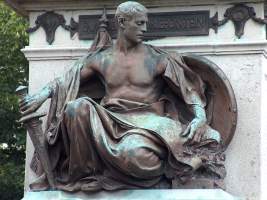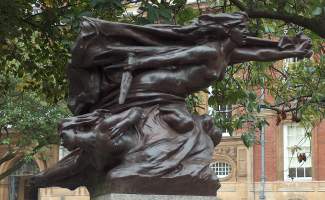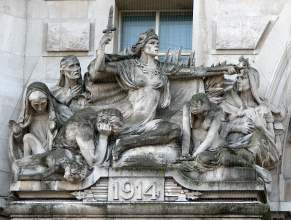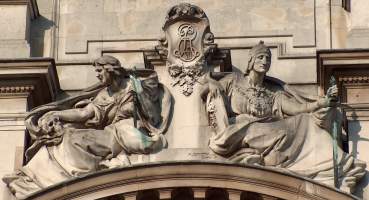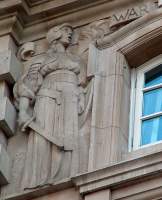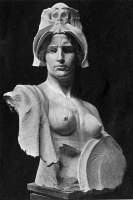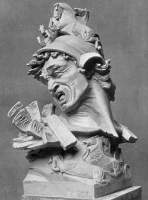W is for War
Cardiff's statue of War, by Albert Toft.
War memorial sculpture is so familiar, that it takes a little thought to conclude that actual figures representing the concept of War itself are rather sparse. Our allegorical statues on war memorials tend to be of Peace, or Courage, or Victory (allegorical statues of Victory are noted on this page). Or we have a soldier in battle or celebrating victory, thus a representative rather than allegorical figure
Crosland McClure's sculptural group entitled War, in Leicester.
There are a few notable exceptions. The Boer War Memorial in Cardiff has a figure explicitly labelled War: a heroic male figure, in classical drapes and with chest bare, holding a short sword, a round shield behind him. It is the work of the sculptor Albert Toft. This short, Roman-style sword (the Roman gladius, or stabbing sword, used by the legionaries), and Classical drapery exposing heroic musculature, are found in other statues of War. Here we have the group of War from the Leicester Boer War Memorial, a strange and arresting group by Crosland McClure. The upper figure carries the sword, and is shown as some sort of Angel of War in full flight, her left arm thrust forward, her hair streaming back, a hard glare on her countenance. Her drapery also stretches back, leaving her body exposed, showing the physique of an Artemis and the shoulders of a Valkyrie (see the Warrior Women page for other such figures).
Allegorical figure of War, and company, by F. W. Doyle Jones.
A few war memorial groups, while not labelled as such, have a figure clearly identifiable as an allegory of War. The largest of these in England is probably the central figure in one of the two groups on the front of Waterloo Station, best seen from railway trains coming in to the station. We see an extremely muscular female figure, with a harsh, mannish face in a grimace of anger. She wears a light helm with bat wings, from which her bristly hair sticks out. Around her neck, thick as that of a bull, hangs a heavy chain with a face of Medusa. She wears chain mail on her chest, while below, diaphanous drapery reveals her hard, muscular stomach and hips. Her right hand holds the familiar short sword, little more than a dagger in length, and her stretched forward left hand holds a burning torch. Her great cloak stretches like wings of darkness behind, with in the rear an array of spears sticking up to form a menacing, spiky silhouette. Around her are a group, mainly female, in various attitudes of vulnerability, grief and despair. F. W. Doyle-Jones was the sculptor of this excellent allegorical group.
Alfred Drury's allegorical statues of War on the Old War Office, Whitehall.
e may go to see the Old War Office in Whitehall for a pair of Edwardian female statues identifiable as allegorical figures of War (or two pairs, for each of the four groups is duplicated around the building). The right hand figure is extremely Roman in face, and wears a Roman helmet. She wears some mail around the neck, and on her neck-band we again see a small warlike head, mouth agape, this time winged, and apparently also indicative of Medusa, with little snakes writhing below. Her shield bears a head of Medusa too. She is heavily draped, at rest, rather than straining forward as in our previous two examples, but her powerful physique is shown in her neck and one bare upper arm. Her sword, of bronze, is rather longer and much thinner than in the previous examples. The left hand figure again holds a sword, or perhaps just a staff, but in her left hand, as her right holds a skull which she contemplates with pained expression. We may envisage the aftermath of a battle or spoil of war. The work is by Alfred Drury.
Allegorical War sculpture by Binney, Bayes, and a weaponless figure.
Some different versions. At the corner of Aldwych is Hibbert Binney's high relief figure of War, an Arts and Crafts version, more allegorical and less warlike, but still with short sword, shield, a Roman helm, and in this case, plate mail on top, though a long skirt underneath of somewhat medieval aspect rather than the Classical drapes we have seen above. Gilbert Bayes made a rather chivalrous version of War, shown above centre, a medieval knight, of Crusader vintage, about to charge in to battle. And above right, another female figure, also entitled War, without any weapons at all. Yet her pose, stretching her arms skywards, fists clenched, her face twisted to one side, suggest fury. She wears a chain mail shirt, and it is her torso emphasised by this rather than the muscularity of her arms or legs which suggests she is a warrior.
Busts by Bertram Mackennal and Albert Hodge.
I wanted to show two busts, both highly evocative of War. Bertram Mackennal's bust of War indicates an Amazon perhaps, as she bares her breasts; we see the part of a drape across one shoulder. We also see a part of a shield, and she wears a strange helm with a bat-winged skull (a death's-head) on top of it. She frowns, and stretches her mouth backward and downward, thickening her chin, expressive of her seriousness and grimness of fixed purpose rather than any rage or sudden violence of emotion. In stark contrast is our second example, above right, a male bust, showing head and a bit of the shoulders, all emphasis on his distorted, snarling face, and the strain in the twisted, great muscle of the neck. The locks of his hair seem to express his seething anger, as do the charging horses on his helmet and the base of the bust. Across his shoulder are the supports for his armour, and the sticking-up elements are rather unlikely, but again add to the sense of bellicosity. A harsh, disturbing work, belonging to the hand of the sculptor Albert Hodge. The title of the work is 'War, Rage, Pain'.
Back to Allegorical sculpture - V // Onward to Allegorical sculpture - Y // Full Alphabet of Allegorical Sculpture
Sculpture in London // Sculpture in England // Sculptors
Visits to this page from 15 Jan 2013: 8,491
